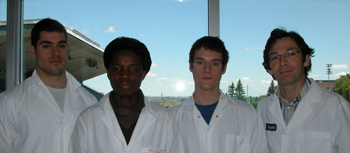 |
 |
|
|
 |
||
| Annual Report | ||
 |
News | |
| MDRC Administration | ||
 |
Directory / Bottin | |
 |
Contact Us | |
 |
Directions / Maps | |
 |
Steering Committee | |
| Research | ||
 |
Events & Seminars | |
 |
MDRC at the forefront | |
 |
McGarry Lecture | |
 |
Cahill Lecture | |
 |
MDRC Core Facilities | |
 |
Scientific Links | |
 |
Education & Employment | |
| Funding | ||
 |
MDRC Grants | |
 |
Donations | |
 |
Non-Profit & Industrial Partners | |
| Medical Information | ||
 |
JDRF | |
 |
CDA | |
 |
Diabetes Quebec | |
 |
ADA | |
 |
IDF | |
 |
NIH / NIDDK | |
 |
Alfediam | |
 |
EASD | |
| Home / About Us > Dr Raynald Bergeron | 
Contact info Dr Raynald Bergeron Tel: 1-514-343-6823
Research keywords
|
|
Raynald Bergeron, PhD
Associate Professor of Kinesiology
Biographical Sketch
Raynald Bergeron received his PhD in exercise physiology from the University of Montreal in 1997. His doctoral work under the supervision of Dr Jean-Marc Lavoie focused on the role of liver metabolism in the modulation of endocrine responses such as during elevated delivery of free fatty acids into the hepatic portal circulation. He then pursued his academic training in the laboratory of Dr Gerald I. Shulman at Yale University School of Medicine. As a post-doctoral fellow in Dr Shulman�s lab, his work supported a role for AMP-activated protein kinase (AMPK) in the regulation of glucose transport and mitochondrial biogenesis in skeletal muscle. Dr Bergeron then joined Merck Research Laboratories in 2001 where, as a senior research biochemist, he played an active role in bringing Januvia®, the first DPP-IV inhibitor to the market. He also was a leader of the research team whose efforts is to develop a pharmacological activator of AMPK activator for the treatment of diabetes. In 2006, he joined the department of Kinesiology of the University of Montreal where he is now associate professor. He became member of the MDRC in 2007. Selected Scientific Contributions
Dr Bergeron�s work, as well as work from other scientists, showed that AMPK is activated during muscle contraction and contributes to skeletal muscle contraction-induced glucose transport in muscles primarily composed of fast twitch muscle fibers and that this was an insulin-dependant event as wortmannin did not suppress contraction mediated elevation of glucose transport. The contribution of acute AMPK activation to glucose transport was shown to be active in both normal as well as insulin resistant rats (fa/fa). This work supported that AMPK-induced stimulation of glucose transport was intact in insulin resistant animals suggesting that this cellular pathway could be exploited pharmacologically to improve defective muscle glucose transport in T2DM. Using an analog of creatine (�-GPA) leading to chronic activation of AMPK, Dr Bergeron also demonstrated that this pathway was associated with skeletal muscle mitochondrial biogenesis. This finding was later confirmed with the use of AMPKa2 muscle specific dominant negative mice. As a scientist at Merck Research Laboratories, Dr Bergeron explored a vast range of animal models of insulin resistance and diabetes. Those models were used to validate and develop pharmacological tools for diabetes targets including AMPK, PPAR, glycogen phosphorylase, glucokinase, acetyl-CoA carboxylase, stearyl-CoA desaturase-1. More specifically, he recently highlighted the beneficial effects of PPARa selective agonist treatment on glucose metabolism and insulin secretion in Zucker Diabetic Fatty (ZDF) rats, a common diabetes animal model. Research Interests
Current projects in the laboratory fall into three areas: Contractile activity of skeletal muscle: Mechanisms leading to improved muscle glucose metabolism in insulin resistant models. Studies focusing on the interaction between reactive oxygen species being generated during acute muscle contraction and AMPK activation in the modulation of glucose transport and metabolism are being conducted. A colony of AMPKa1 KO mice is being used to investigate this research area. Effect of physical activity on insulin secretion in diabetes prone individuals. Although the effects of regular physical activity on peripheral insulin sensitivity are well documented, outcomes on insulin secretion are not clear. Using ZDF rats being physically trained on a voluntary basis in wheel cages, we have developed a model to study both in vivo as well as in vitro (isolated islets) dynamics of insulin secretion in response to physical activity in a rat strain with a high genetic propensity to develop diabetes. Studies focusing on the role of oxidative stress in relationship with islet substrate metabolism in the modulation of this training effect on the �-cells are underway. Study of interactions between exercise training and antihyperglycemic agents on glucose control. Dr Bergeron�s laboratory is currently developing new diabetes animal models to diversify observations and gain more confidence in the relevance of such models to the human disease. Those models will be used to better investigate potential benefits and adverse effects of combining physical activity and antihyperglycemic pharmacological agents under development as more and more diabetic patients become active, as recommended by health professionals, while taking medications.  |
|
| � Montreal Diabetes Research Center 2018 |
| Home / About Us News Directory / Bottin Contact Us |